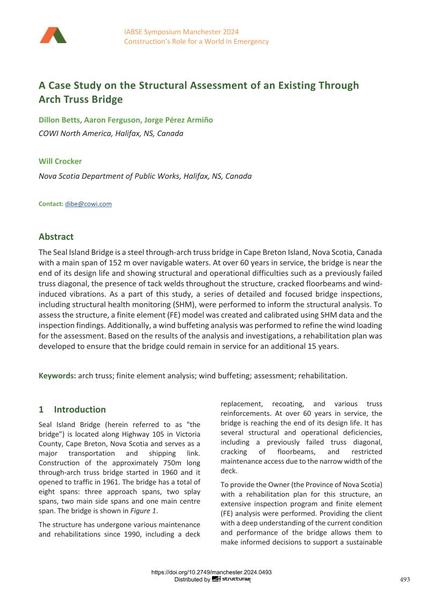A Case Study on the Structural Assessment of an Existing Through Arch Truss Bridge

|
|
|||||||||||
Bibliographic Details
| Author(s): |
Dillon Betts
(COWI North America, Halifax, NS, Canada)
Aaron Ferguson (COWI North America, Halifax, NS, Canada) Jorge Pérez Armiño (COWI North America, Halifax, NS, Canada) Will Crocker (Nova Scotia Department of Public Works, Halifax, NS, Canada) |
||||
|---|---|---|---|---|---|
| Medium: | conference paper | ||||
| Language(s): | English | ||||
| Conference: | IABSE Symposium: Construction’s Role for a World in Emergency, Manchester, United Kingdom, 10-14 April 2024 | ||||
| Published in: | IABSE Symposium Manchester 2024 | ||||
|
|||||
| Page(s): | 493-499 | ||||
| Total no. of pages: | 7 | ||||
| DOI: | 10.2749/manchester.2024.0493 | ||||
| Abstract: |
The Seal Island Bridge is a steel through-arch truss bridge in Cape Breton Island, Nova Scotia, Canada with a main span of 152 m over navigable waters. At over 60 years in service, the bridge is near the end of its design life and showing structural and operational difficulties such as a previously failed truss diagonal, the presence of tack welds throughout the structure, cracked floorbeams and wind- induced vibrations. As a part of this study, a series of detailed and focused bridge inspections, including structural health monitoring (SHM), were performed to inform the structural analysis. To assess the structure, a finite element (FE) model was created and calibrated using SHM data and the inspection findings. Additionally, a wind buffeting analysis was performed to refine the wind loading for the assessment. Based on the results of the analysis and investigations, a rehabilitation plan was developed to ensure that the bridge could remain in service for an additional 15 years. |
||||
| Keywords: |
finite element analysis FEA rehabilitation assessment wind buffeting arch truss
|
||||
